Plants in the genus Cotoneaster (prounced co-to-ne-as-ter, not cot-on-easter) are very popular with north American gardeners, and not without good reason. Cotoneasters are variable in form, from prostrate low-growing ground-covers, to tall arching shrubs, and may be evergreen or deciduous depending on species, making them very versatile in the garden.
The genus name Cotoneaster is from the latin cotneum, meaning ‘quince’, and the suffix -aster meaning ‘imperfectly resembling’. Cotoneaster franchetii was named specifically after the French botanist Adrien Rene Franchet (1834-1900). This species, also known as Orange Cotoneaster, or Franchet’s Cotoneaster, is native to Southwestern China, Thailand, and Myanmar.
Cotoneaster franchetii is a fountain-shaped shrub capable of growing up to 3 meters in height, with oval 2-3 cm long broad leaves, that are shiny above, with dense hairs below.
The cup-shaped flowers appear in mid-spring, are pale pink in color, and are produced in small clusters called corymbs.
The berries appear in late summer, are small, 5-8 mm in diameter, and reddish-orange in color when mature.
At first glance Cotoneaster franchetii would seem to be an ideal habitat plant with its delicate spring blooms frequented by bees and butterflies, and the profusion of berries in fall and winter that are favored by birds. However, all is not as it first seems.
Here in the Santa Cruz Mountains, and throughout northern and central coastal California, Cotoneaster franchetii is listed by the California Invasive Plant Council (Cal-IPC) as a moderately invasive pest species!
Cotoneaster franchetii is thought to have been introduced to California from China in the mid 1850s, soon thereafter escaping cultivation. Although Cotoneasters grow well in manicured, fertile garden landscapes, in full sun to part shade, plants in this genus also do very well in our lean native California soils, thriving on dry sandy slopes, and serpentine soils. Thus, once escaped from the garden they can run amok in our wild-land areas, displacing both native plant, and animal species.
Although our deer here do eat this species, sadly they don’t seem to favor it enough to aid in its elimination from the property, and even this shrub, that was heavily pruned by a grazing doe earlier in the season, has succeeded in setting fruit this fall.
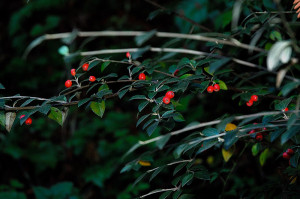
Despite heavy deer damage in spring, this plant has still set fruit this fall, with each berry a potential new plant
Thus far we’ve noted two mature specimens of C. franchetii on the property. Although one plant is close to the house, and might have been intentionally planted by the previous owner, the other specimen is in an undisturbed wild area of the property, and most likely a volunteer. As this is the time of year when Cotoneaster is the most noticeable, with few species native here producing red berries this time of year, close scrutiny of our woodland understory plants should help us to locate any other rogues that are lurking amidst the shrubbery this winter.
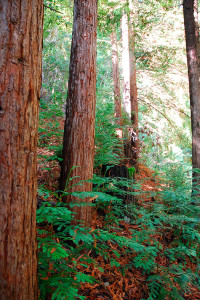
Here Cotoneaster franchetii seems to favor growing in partial shade at the edge of our redwood groves
Berries are spread primarily by birds, but can also be distributed via waterways, so with two creeks on the property it’s important for us to ensure that this species is not permitted to grow along the creek banks to prevent its spread further downstream.
Although for us C. franchetii is the species of the most concern here, other species of Cotoneaster are also invasive in this part of California, including Cotoneaster lactea, and the silverleaf Cotoneaster, C. pannosus.
Removal is not as simple as cutting the shrub to the ground, as Cotoneaster species will produce numerous stump sprouts when cut. Although small plants may be removed manually, larger specimens develop extensive root systems making complete removal difficult. There are two recommended methods of removal for specimens of significant size. [1]
The first is to cut the shrubs close to the ground in late fall, and apply a concentrated herbicide to the stump.
The second recommendation is to cut the trunk to approximately one foot above ground level after fruit set (but before fruit fall), and then to anchor landscape fabric over the stump, and around the plant two feet in diameter, and leave the fabric in place for at least 12 months to minimize the likelihood of the shrub re-sprouting. The purpose of the fabric is primarily to reduce sunlight to prevent regrowth. This second method, as it doesn’t require the use of herbicides, is the method of removal we’ll attempt this year to eliminate this species from the property.
If you live along California’s coast, Cotoneaster franchetii tends to thrive in the same areas favored by an excellent alternative, and native species, Toyon (Heteromeles arbutifolia), also known as Christmas Berry. Toyon is also evergreen, produces delicate white blossoms in the spring to appease the bees, and large clusters of red berries in the fall, which are just as appealing to the birds. Farewell C. franchetii, we’re replacing you with Toyon!
—————
[1] Cal-IPC Weed Workers Handbook Series – Cotoneaster Species (PDF)


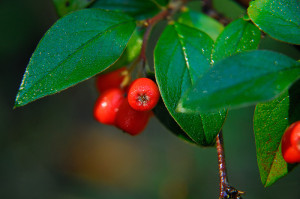
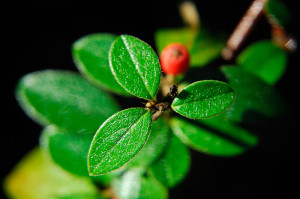

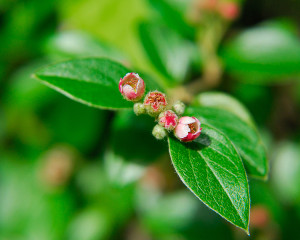
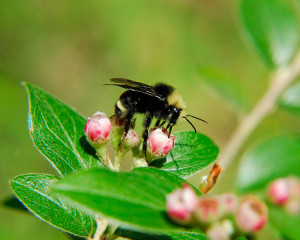
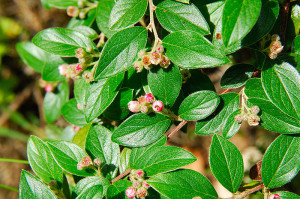
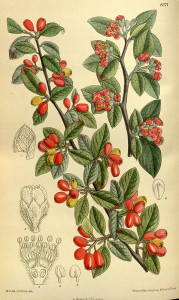
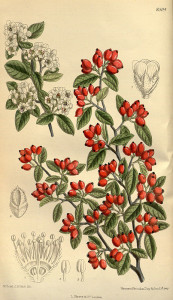








Clare, We have invasives that are as difficult to get rid of, too! It’s very frustrating when I see them still offered in nurseries and big box stores. Good luck with the cut and smother technique~it sounds like a much better alternative to chemicals. gail
Just crossing my fingers the ‘cut and smother’ approach works. Considering piling some mulch over the weed blocker fabric. If blocking light is the main goal to prevent re-sprouting, entombing it in mulch shouldn’t hurt! 😉
A redwood grove, I am in love. It looks like a heavenly spot with the cotoneaster understory. In fact I have some to send your way. They grow like weeds here.
It’s good that you are managing your property in a responsible manner. It would be a big job to take care of land like that. How beautiful those redwoods are!
We know we’re very fortunate to have a number of healthy redwood groves on the property, and it’s part of what sold us on moving here. If we can encourage more to grow, more the better! There are also a number of old growth, burned out, and hollow stumps of old redwoods, remainders from when this area was clear cut at the turn of the 20th Century. In some respects, although those trees are now gone, their remnants are no less special.
Ugh. How I hate cotoneaster. The birds seem to drop their seeds everywhere. Toyons are so similar yet have a much nicer colored berry. A much deeper red compared to the orangish-red of the cotoneaster. Good luck smothering it. Do they resprout from the roots or just the stumps? Would it be to hard to cut the roots around the stump and pull that out.
I’m honestly not sure how extensive the roots are on the plants here. However, if by late spring the ‘smothering’ technique isn’t having the desired effect, we might try resorting to digging them out with the backhoe on the tractor. We’ll try the more passive approach first though, as we don’t want to turn up other invasive weeds by disturbing the soil more than we need to!
I never guessed this plant would be an invasive. I only know it from Christmas ornaments and decoration.
I always found it very pretty tho.
Good luck getting rid of it
It is a pretty plant, but I think its replacement will be beautiful too, and much better suited to this area.
As a Californian native we don’t grow this plant although I have seen it in the Botanic Gardens Glasnevin. I didn’t known it’s common name Toyon although I have heard of it’s other common name California Holly. I did some research about Toyons’ wildlife value and was delighted to see that this plant is visited by butterflies, the fruit are consumed by birds, including mockingbirds, American Robins and Cedar Waxwings; and mammals including coyote and bear also eat and disperse the berries.
I don’t envy you the task of trying to eradicate this thug. Here in Ireland Cotoneaster integrifolius [Cotoneaster microphyllus]and Cotoneaster simonsii are invasive yet both are still planted.
Best of luck with your task.
I find it frustrating that invasive plants are readily available on the market for the unsuspecting. I hope your eradication efforts are successful!
Considering how much money is spent each year eradicating escaped cultivars from our wild-lands, I’m surprised that sales of certain species aren’t more heavily regulated, at least in areas where they are problematic. As consumers, all we can really do is educate ourselves, and avoid frequenting nurseries and garden centers that persist in selling invasive species.
Dear Clare, Cotoneasters are, as you say, very versatile and generally useful shrubs. However, seeing them on a regular basis as ‘ground cover’ in planted areas of supermarket car parks, I am growing less fond of them.
As for your Redwood Grove…..that is simply lovely.
Thank you Edith, we love our redwoods too. We’re very fortunate to have a number of groves around the property, and we’re doing all we can to encourage the redwoods here, including relocating some young trees around the property. They are definitely our favorite tree here!
Thanks for highlighting the evil Cotoneaster! Another alternative to it besides Toyon could be Coffeeberry (Rhamnus californica). Both plants are so much prettier than that garish orange color. Good luck smothering the bastard!
That’s a good point Christine. I picked up my first Coffeeberry at a CNPS sale last month, which is laden with berries. I’d love to try propagating them, and the plants do seem to prefer partial shade, and get to be quite large too. In the meantime, our smothering of the Cotoneaster commences! 😛
Great post!! I am a big fan of Cotoneaster. Down in Sonoma a neighbor had four great big vines of it trained vertically up a wall in an espalier display – it was gorgeous. It really takes kindly to being closely trimmed to shape, and it loves to climb, the kind of thing Edward Scissorhands would love to work on! And the robins looked great on that espalier grabbing the berries in late Fall. Thank you for stopping by my blog!! You mentioned poison oak – now that is truly a gorgeous Fall foliage plant, sincerely. I recall horseback riding in the Sonoma hills surrounded with flame-red PO thickets – lovely colors backlit in the low Fall light. Truly a California landscape essential – in the wild!! I too am horribly allergic and have had it many times in all the worst places. Did you know that the little berries of PO are exceptionally nutritious, and are a Fall diet staple for many birds? I got a “mock” Poison oak called RHUS TRILOBATA from Wayside Gardens five years ago. It is a lovely ornamental shrub that looks just like the real thing (!) but without the irritant oils – it is the one and only plant that I brought up to WA from CA. Brings back lots of memories for me. It loves it up here and is a great big bush that I just divided in fact. Last time I checked Wayside they did not carry Rhus Trilobata but if you see it, it’s a beauty. Cheers!!! Bonnie
Excellent post Clare! I love this plant and you have illustrated with words and images how perfectly lovely and useful a plant/shrub it truly is. ;>)
It is a lovely plant, it’s just unfortunate that it’s a bit lacking in manners. I expect our wild creatures here will love its replacement even more! 😉
It’s always interesting to hear what is invasive on the west coast vs the east coast. We have cotoneaster growing here in central MA (planted by a former owner) but I don’t believe it is at all invasive in this cold climate…I always heard that birds eat the berries but despite having loads of birds here (we are a certified backyard habitat) I never see them eating the cotoneaster berries….although the berries disappear by the end of the winter so somebody IS eating them. We have it growing in an area next to a footpath and my ‘loves trim hedges’ hubby shears the sides of it so it forms a low, dense twiggy hedge that birds do seem to use for winter protection. But if something happens to the cotoneaster, I won’t be crying and will replace with something native and more beneficial…hmm, full sun, prime garden space, maybe the cotoneaster could have an – er – unfortunate accident 🙂
I really like some types of cotoneaster and it’s a valuable source of food for the birds in my garden. Mine are horizontalis which grows up the wall of the house and the other is trained as a weeping standard. I’ve seen your cotoneaster for sale here but it never made any impression on me as a shrub for the garden.
Clare I hope there are not too many on your property as you’ll be quite busy eradicating them – though I wouldn’t mind walking through your redwoods trying to source them.
My Cotoneaster salicifolius, the Willow-leaved Cotoneaster, used as a ground cover has seen it’s better day and finally checked out!
I was unaware that cotoneaster could be invasive. I have a low growing, horizontal grower which I planted on a hillside as a ground cover. I haven’t seen extra plants sprouting anywhere, but the original six have done a great job of spreading, which is what I wanted. I will have to watch out for unwanted babies!
I love shrubs and trees with dark green foliage and bright berries and flowers. It is easy to see why this is such a popular genus 🙂
I work in the Golden Gate National Recreation Area and, needless to say, cotoneaster is all over. It’s hard not to hate it when it’s outcompeting CA natives (go Toyon!), but it is a pretty one, regardless.
Also, I love how you immediately noted how to “correctly” pronounce it. Just yesterday I was passing by one and was thinking how I’d type out how to say it.
Beautiful as they can be, I’m grateful you are doing your part to remove the Cotoneasters and replace with Toyon. I hope your neighbors are as careful so you needn’t struggle with the plants year after year.